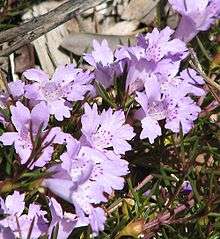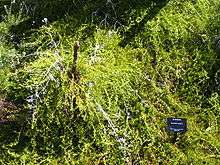Hemiandra pungens
| Hemiandra pungens | |
|---|---|
 | |
 | |
| Scientific classification | |
| Kingdom: | Plantae |
| (unranked): | Angiosperms |
| (unranked): | Eudicots |
| (unranked): | Asterids |
| Order: | Lamiales |
| Family: | Lamiaceae |
| Genus: | Hemiandra |
| Species: | H. pungens |
| Binomial name | |
| Hemiandra pungens R.Br.[1] | |
Hemiandra pungens, commonly known as snakebush, is a shrub or trailing plant that is endemic to south-west Western Australia.[2] Ranging in height from 5 cm to 100 cm, it occurs on rock outcrops.[2] The spotted flowers may be white, pink or bluish-purple and appear throughout the year.[2]
The species was formally described in 1810 by Scottish botanist Robert Brown[3]
The widely cultivated variety known as Hemiandra pungens var. glabra is currently classified under the species name Hemiandra glabra[4][5] and considered a mere synonym of the nominal species.[6]
References
- ↑ "Hemiandra pungens R.Br.". Australian Plant Name Index (APNI), IBIS database. Centre for Plant Biodiversity Research, Australian Government. Retrieved 10 February 2014.
- 1 2 3 "Hemiandra pungens R.Br.". FloraBase. Western Australian Government Department of Parks and Wildlife.
- ↑ "Hemiandra pungens". Australian Native Plants Society (Australia). Retrieved 10 February 2014.
- ↑ "Hemiandra pungens var. glabra (Benth.) Benth. [ nom. illeg. ]". Australian Plant Name Index (APNI), IBIS database. Centre for Plant Biodiversity Research, Australian Government. Retrieved 10 February 2014.
- ↑ "Hemiandra glabra Benth.". Australian Plant Name Index (APNI), IBIS database. Centre for Plant Biodiversity Research, Australian Government.
- ↑ The Plant List, vers. 1, 1, 2013, access date 18 November 2015
| Wikimedia Commons has media related to Hemiandra pungens. |
This article is issued from Wikipedia - version of the 11/18/2015. The text is available under the Creative Commons Attribution/Share Alike but additional terms may apply for the media files.